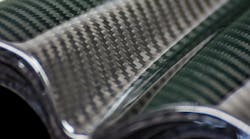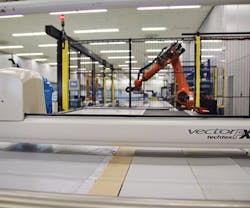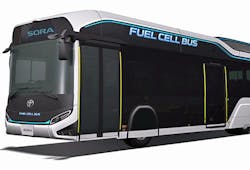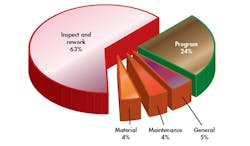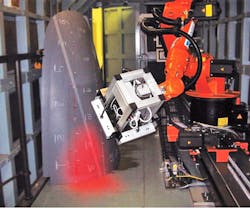As the trend to make things lighter and stronger continues to ramp up across many industries, it’s no surprise that the demand for carbon-fiber (CF) composites is greater than ever, too. However, CF can have drawbacks—mainly cost and production time. Though materials costs have decreased over the years, labor remains the biggest contributor to high cost and long production times.
Fortunately, companies are working on automated composite manufacturing (ACM). This article will go over some of the applications that benefit from ACM, and why the market may not adopt this technology as fast as other automated processes.
With rising regulations in the automotive market, lightweighting is becoming more important. Reducing weight in automobiles also increases performance and acceleration. In other industries, regulations may not drive the market, but lightweighting is still necessary to stay competitive. Airlines are able to save a lot of money on fuel for every pound they can reduce from a plane. Virgin Atlantic estimated the reduction of just one pound in weight from all of the planes in its fleet would save 14,000 gallons of fuel per year (stated at a time when Virgin Atlantic had about 52 airplanes).
Automating the Process
It’s fair to say that introducing automation as early as possible to a process may very well translate to earlier success for the company. Before the carbon fiber is cut, designers can use better CAD software to optimize the process before it starts. Layups can be optimized and simulated for automated machinery.
CAD packages with simulation are relatively new, and have only come into their own in the last few years. However, today there are more programs for CF parts. For instance, companies like VERICUT composite programming and simulation packages can simulate a part layup and machine motion.
Kitting
The next step in a CF process is to cut the shapes. Automated cutting has been around for a while, but the tasks of organizing the sheets, layup, and inspecting still must be performed. Airborne developed a new machine that will take the cut materials and remove them from a line, and subsequently organize the sheets in the order needed by a technician to lay up a part. This sounds like a complex way to generate kits for technicians, but it stands as an example of how reducing labor is important in CF processing.
Another problem that crops up with CF processing is production time. If manufacturers continue to operate with a manual method, production times could inhibit facilities and lead to a loss of sales. According to Lucintel, the composite materials market is expected to reach $38.5 billion, and end products around $109.4 billion, by 2022. This is a far cry from Allied Market Research’s estimates of $4.7 billion. However, the numbers in both cases show large market gains from 2015 where, according to Allied Market Research, the market was $2.2 billion.
(Credit: Clean Energy Manufacturing Analysis Center, CEMAC)
With growth, sometimes cost isn’t as important as delivery time. One of the reasons plastics became so popular was the ability to process faster. CF manufacturers that want to capture as much market as possible have to meet tough time-to-market deadlines and delivery dates. This can be difficult for mass production, or large parts.
Applications
On November 2, Toyota announced it had developed a large part that will also be mass-produced—a multi-material roof consisting of aluminum, CF, and other materials will be applied to a fuel-cell-powered bus. With projects of this magnitude, automation will be imperative to success.
(Credit: Toyota)
Currently, automated layup machines are mostly found in large Fortune 500 companies that need to produce a lot of CF parts. Along those lines, a passage from the paper “A Roadmap to Automated Composites” remarks “One of the most obvious reasons why Boeing chose to build the front and rear spars of the 777x wing with ACM instead of the hand layup process is the 236 foot wing span—a massive amount of material to place. By utilizing the strengths of automated fiber placement, Boeing designed and initiated efforts to accomplish that monumental feat. Boeing isn’t the only company to understand that in the right setting, ACM is better and financially superior in the long term when compared to hand layup.”
Companies like Electroimpact have advertised feed rates of up to 660 lbs. per hour for a given machine and part configuration. By comparison, a worker might manually lay up two to three pounds per hour. However, the cost of these machines can hold back integration. In addition, the automated machines aren’t completely user-friendly, and there is still a steep learning curve. The cost and time to integrate ACM are the main reasons companies aren’t investing in it, despite proven advantages.
Fortunately, as new developments unfold within the industrial Internet of Things, it could be possible for a company to offer a subscription model to a manufacturer. This would allow a lower cost of entry. Plus, the OEM would have a vested interested in making sure that its machine was able to be quickly integrated, and that employees were properly trained in how to operate the equipment. This could be a new way to accelerate CF production and give a smaller company a leg up in the market.
Here’s a breakdown of overall time spent on different processes during part fabrication for a 787 fuselage barrel.
Automation can provide increased throughput, better quality, and reduction of labor cost. However, when working with composites reproducibility is a large advantage. If parts are being laid-up by hand, reproducibility can be difficult or have looser tolerances. The paper “A Roadmap to Automated Composites” also mentioned that numerous technicians might interpret blueprints in different ways. With an automated system, blueprints will be interpreted one way every time.
With the cost and knowledge needed for automating the layup process, some companies are focusing on inspection. The paper continues, “Inspection assistant technologies exist to help mitigate the largest section of time spent on inspection and rework. One such tool is a long throw laser projector mounted in the work cell, or on the motion platform of the machine. By utilizing feedback from the CNC on events like dropped tows (an automated fiber placement process failure), the laser projector can project areas of possible rework to reduce the time spent by the inspector identifying them.
“A standard acceptable machine tolerance for dropped tows is one in three thousand. Given the diligence and effort required in manually finding approximately sixty process failures in 180,000 events, even highly skilled inspectors fail to catch every defect. By utilizing the joint benefits of automated inspection with automated manufacturing, as much as thirty percent of the time of the part build could be saved.”
Having in-line testing and inspection is desirable, so that parts don’t have to be removed from production and manually inspected. In addition, in-line inspections are non-destructive. Non-destructive testing (NDT) means production can immediately be increased by the percent of parts tested (if they test properly). Also, NDT in-line can test more parts that may offer data to the process, including how the process can be adapted to prevent parts from ever testing poorly (Credit: CompositeWorld.com)
Inline quality inspection is a trend popping up in 3D printing and solar-panel manufacturing, and is growing in composite processing. Inline inspection saves both time and cost. The systems currently being launched are able to detect defects stored in a database, and then analyze them to create maximum benefit for productivity.
CF manufacturing can be complicated. As the trends of making parts stronger, lighter, and faster persist, we’ll see continued growth of materials like CF. Companies that come up with a fast, efficient, quality process to make parts will succeed in capturing a part of this constantly growing market. Finding more user-friendly machines that can cost-effectively be installed into current manufacturing lines may realize the biggest success.
